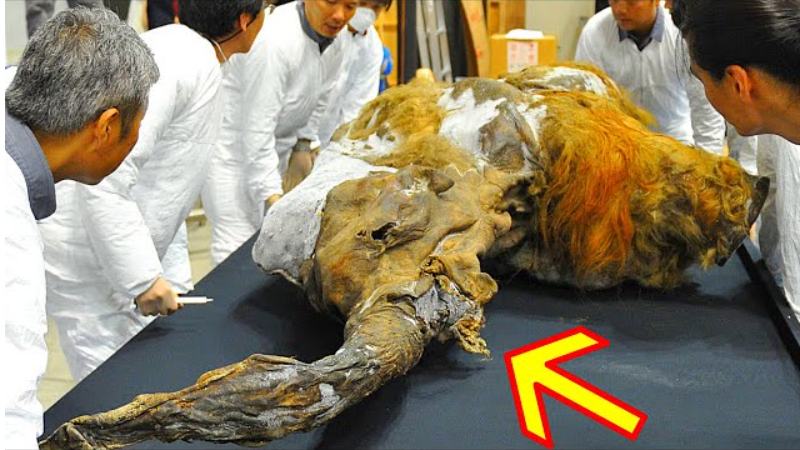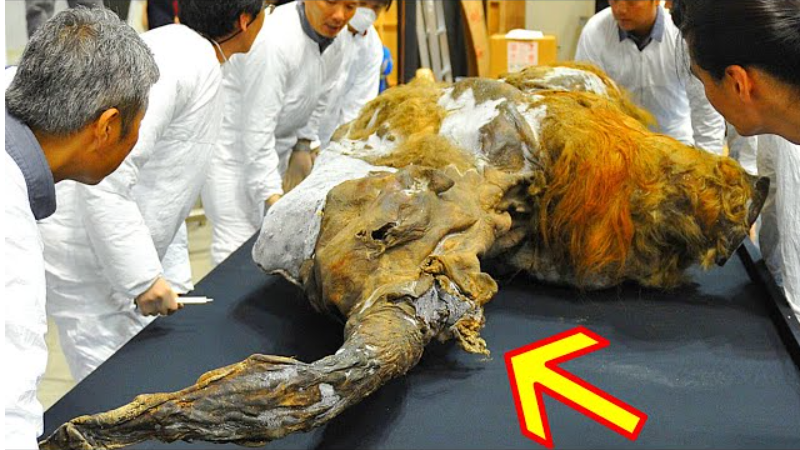Scientists Discovered Evidence That Exposes An Ancient Lie About Woolly Mammoths (Video)

Scientists Discovered Evidence That Exposes An Ancient Lie About Woolly Mammoths (Video)
For centuries, woolly mammoths have been an iconic species that once roamed the planet. Although they don’t exist anymore, we can easily imagine the giant, hairy creatures. However, recent discoveries have shown that our ideas about the way they lived were incorrect. Scientists have found evidence that challenges what we once thought to be true about woolly mammoths.

The frigid temperatures of the Ice Age preserved the carcasses of woolly mammoths until they were discovered in more recent times, providing experts with a clear picture of what they looked like, what they ate, and how they interacted with prehistoric humans. Cave paintings also depict these giant mammals before they became extinct.
While scientists once believed that woolly mammoths died out long before humans appeared on the scene, most of them actually disappeared between 14,000 and 10,000 years ago. In comparison, the ancient Egyptians built the Great Pyramid of Giza over 4,000 years ago, making it clear that woolly mammoths have been extinct for a very long time.
But they do have some relatives roaming the Earth today, namely the Asian elephant, which remains the closest living species to the ancient tusk beast. But it wasn’t through these living creatures that scientists made their new discovery about woolly mammoths. On a remote island, they unlocked a secret about this prehistoric species, and it changed their story completely.
Chances are, upon hearing the words ‘woolly mammoth,’ you can conjure up a mental image of this prehistoric creature. They loomed tall over the icy plains on which they lived, inhabiting an extra-large stretch of the Earth. In fact, these creatures counted northern Eurasia and North America as part of their natural habitat.
Woolly mammoths had similar measurements to today’s African elephants. Males stood up to 11.2 feet in height and weighed in at 6.6 tons. Females stood slightly smaller, with shoulder heights between eight and a half and nine and a half feet and weights around four and a half tons. Their babies came into the world at around 200 pounds, also similar to elephant calves born at present.
Regardless of their age, size, or gender, fur-covered woolly mammoths had both under and outer coats to keep them extra warm in their ice age surroundings. To that end, they had much shorter ears than elephants, which made them less susceptible to frostbite and heat loss.
Perhaps the most recognizable feature of the woolly mammoths were their curved tusks. They used them for a myriad of reasons, namely to defend against pack-hunting predators such as cave hyenas, wolves, and large wild cats. Between themselves, the mammoths used their tusks to attract mates and ward off rival herd members, much like their elephant descendants.
Woolly mammoths lived extremely social lives and stayed in family groups led by their female members. They also may have combined families to create extra-large herds, something which today’s elephants continue to do naturally.
The openness of their habitat would have encouraged them to join up and wander together. Much of the woolly mammoth herds’ days would have been spent looking for food and eating it.
These six-ton creatures would likely have eaten close to 400 pounds of sustenance each day, requiring them to spend about 20 hours a day foraging. They typically consumed grasses and sedges, although they also ate shrubs, moss, herbaceous plants, and tree parts.
The woolly mammoth’s trunks had a finger-like adaptation at the tip that made it easier for them to dig up even the shortest blades of ice age grass. They could also pick up larger tufts of turf, as well as flower buds and leaves from trees and shrubs. In comparison, today’s elephants are less exacting; instead, they wrap their trunks around long savannah grass and pull it.
Despite their family-centric nature and plant-based diets, woolly mammoths didn’t lead a peaceful existence. They had a slew of predators to deal with during their time on Earth. Young or otherwise weakened mammoths had to worry about facing attacks from saber-toothed cats. These same sick or small woolly mammoths would also be susceptible to attacks by pack predators such as the aforementioned wolves and hyenas.
Then, about 40,000 years ago, a new threat made its way into the mammoth’s extensive habitat: human beings. Around that time, humans trekked from Africa and into Europe, discovering the giant hairy creatures.
Before the evolution of humans, Neanderthals too had lived alongside the woolly mammoth. In fact, humankind’s ancestors repurposed the mammoth’s bones to fashion tools and sturdy building materials. Neanderthals honored these creatures by adding them to their cave drawings and paintings, some of which endure today.
But the relationship between humans and mammoths would eventually become exploitative. It started with mankind’s use of bones to build their homes. Some structures remain standing today, showing just how much of the mammoth was required to construct an ice age dwelling.
First, these ancient humans would gather the woolly mammoth’s largest bones and use them to outline the home’s foundation. They then used its tusks to mark the entryway to the dwelling and to enclose it all. The people would wrap their abodes in mammoth skins, although some of the animals used in this process had been long dead, and their bodies repurposed; others were killed for building alone.
Much like today’s elephants, woolly mammoths also faced exploitation for their ivory. Humans used the cream-colored material for carving artworks and weapons. The massive size of the mammoth’s teeth meant that humans had to chisel and split the tusks into smaller pieces before they could use them for anything people-sized.
Finally, humans relied on the woolly mammoth for food too. Some remains of the massive mammals show that they’d been butchered by stone tools. One set of remains even had a spearhead lodged into its shoulder, showing how forcefully a human had killed it. Cave paintings also revealed that humans used trapping pits to capture woolly mammoths too.
Nevertheless, experts can’t confirm how much prehistoric people relied on sustenance from woolly mammoths. Some believe that humans were the driving force behind the species’ extinction, which may have occurred due to overhunting. On the other hand, some scientists say that climate change and subsequent loss of habitat killed off the woolly mammoth. Experts nevertheless agree that the majority of mammoths died during the so-called Quaternary extinction event, which began about 40,000 years ago.
During the Quaternary extinction event, most megafauna species perished. These types of animals measured in at similar or larger mass sizes than humans, and the mass extinction affected many of the most well-known prehistoric creatures. Along with the woolly mammoth, the woolly rhinoceros, saber-toothed cat, giant polar bear, and ground sloths disappeared.
But modern research has revealed that the woolly mammoth may not have actually disappeared completely during the Quaternary extinction event. Instead, scientists have found evidence that a colony of woolly mammoths survived thousands of years beyond that moment. Climate change inadvertently quarantined a small population of mammoths on Wrangel Island. This expanse of land floats in the Arctic Ocean and is bookended by the Chukchi and East Siberian Seas.
At the end of the Ice Age, rising temperatures caused water levels to rise, so the mammoths couldn’t leave Wrangel Island for the mainland. But isolation on Wrangel Island helped to save these last mammoths from sure death on the mainland. Instead, they ended up living in the middle of the Arctic for an additional 7,000 years.
Scientists uncovered this information in a study meant to measure the isotope makeup of the carbon, nitrogen, sulfur, and strontium in bones left behind by the extinct creatures. The bones came from all different parts of the mammoth’s habitat: Alaska, the Yukon, northern Siberia, and of course, Wrangel Island. Scientists hoped that the study would not only highlight how the mammoth’s diets had changed toward the end of their existence but also discover how their environment had changed.
The bones from the Wrangel Island mammoths presented a completely different story than that of their mainland counterparts. The University of Helsinki’s Dr. Laura Arp led the study and shared the results in 2019.
In the findings, the experts stated the results showed that Wrangel Island’s mammoth’s collagen carbon and nitrogen isotope compositions didn’t shift as the climate warmed up some 10,000 years ago. The Wrangel Island mammoth’s composition remained the same until they too disappeared, albeit 7,000 years later than the majority of the species. Even when they died, the scientists said they perished from the midst of stable, favorable living conditions.
It makes sense then that mainland mammoths died with much different isotope levels. The study scientists looked at both mammoths that died in eastern Europe about 15,000 years ago as well as Alaskan behemoths that perished 5,600 years ago. They found that in both cases, the last representatives of these populations showed significant changes in their isotopic composition. This indicated changes in their environment shortly before they became locally extinct.
It’s not a mystery as to how the Wrangel Island mammoth thrived while the rest of the population disappeared. The ones isolated on the island began to develop mutations that changed their body’s fat metabolism, and experts have long known this. The latest study revealed that typical mammoths processed fat and carbohydrates differently than those trapped on the island.
Mammoths in Siberia had to survive harsh ice winters, which meant that their lives depended on their body’s fat reserves. On Wrangel Island, though, conditions proved to be much milder; therefore, those mammoths simply didn’t need to rely on the stored-up fat, Dr. Arp explained according to CY News. Additionally, mammoths on the island had to deal with the deteriorating quality of their drinking water too.
This occurred as the bedrock became weathered during the massive changing climate. Sulfur and strontium appeared in the mammoth bones, suggesting that it may have been in the water.
Despite the changes in water, however, Wrangel Island’s mammoths endured. In the study, scientists revealed that this isolated population lived into the Holocene period, in which we currently live. Some of the island’s mammoths may have made it to the present era, surviving in the middle of the Arctic while the ancient Egyptians built their pyramids halfway around the world.
Scientists have yet to discover why the Wrangel Island woolly mammoths disappeared after so many thousands of years, but they have at least one theory. For starters, they said it might have been a short-term crisis, possibly linked to climatic anomalies or perhaps geochemical changes. On top of that, Wrangel Island mammoths may have become extinct in a similar way to the mainland population’s potential demise.
The scientists cannot find evidence of humans on the island, but they added that such a lack of evidence should not be used to rule out hunting as the reason why the final mammoths disappeared.
However, some scientists hope that the Wrangel Island community will not be the last of the woolly mammoths to walk the Earth. Many preserved bodies have been recovered, and an estimated 150 million are still frozen beneath the Siberian tundra. As a result, experts believe they may have the genetic material necessary to regenerate the species.
In March 2019, the journal Scientific Reports published the results of a study which revealed that experts had woken up 28,000-year-old woolly mammoth DNA. The team had taken cells from the mummy of a mammoth known as Yuka.
Then, they injected the DNA into mouse eggs to see how the prehistoric cells would react. At first, the mammoth’s chromosomes did indeed wake up, started exhibiting the typical behaviors of a cell just before it divides. However, the DNA abruptly stopped moving, and scientists took this to mean that Yuka’s genetic code had been damaged over time. After all, it had apparently been frozen in Siberia permafrost for almost 30,000 years.
Of course, scientists had known that Yuka’s DNA could be damaged. They chose to inject it into the mouse for that reason; damage to the extinct creature’s genetic code could be repaired by the modern living cells.
At first, the mouse eggs did do this, but they ultimately could not fix the severely degraded quality of the mammoth’s genetic makeup. Researchers from the study wrote, “The results presented here clearly show us again the de facto impossibility to clone the mammoth by current nuclear transfer technology.”
But other experts have thrown their hats in the ring, and they’re relying on a different set of technology to potentially bring this massive mammal back to life. For instance, a team at Harvard hopes to inject woolly mammoth DNA into that of an Asian elephant, their closest living relative. Of course, such projects remain controversial.
Although the mammoths endured for even longer than previously thought, they have gone extinct, and some experts believe that such efforts should be focused instead on modern species that we may lose without conservation.”




